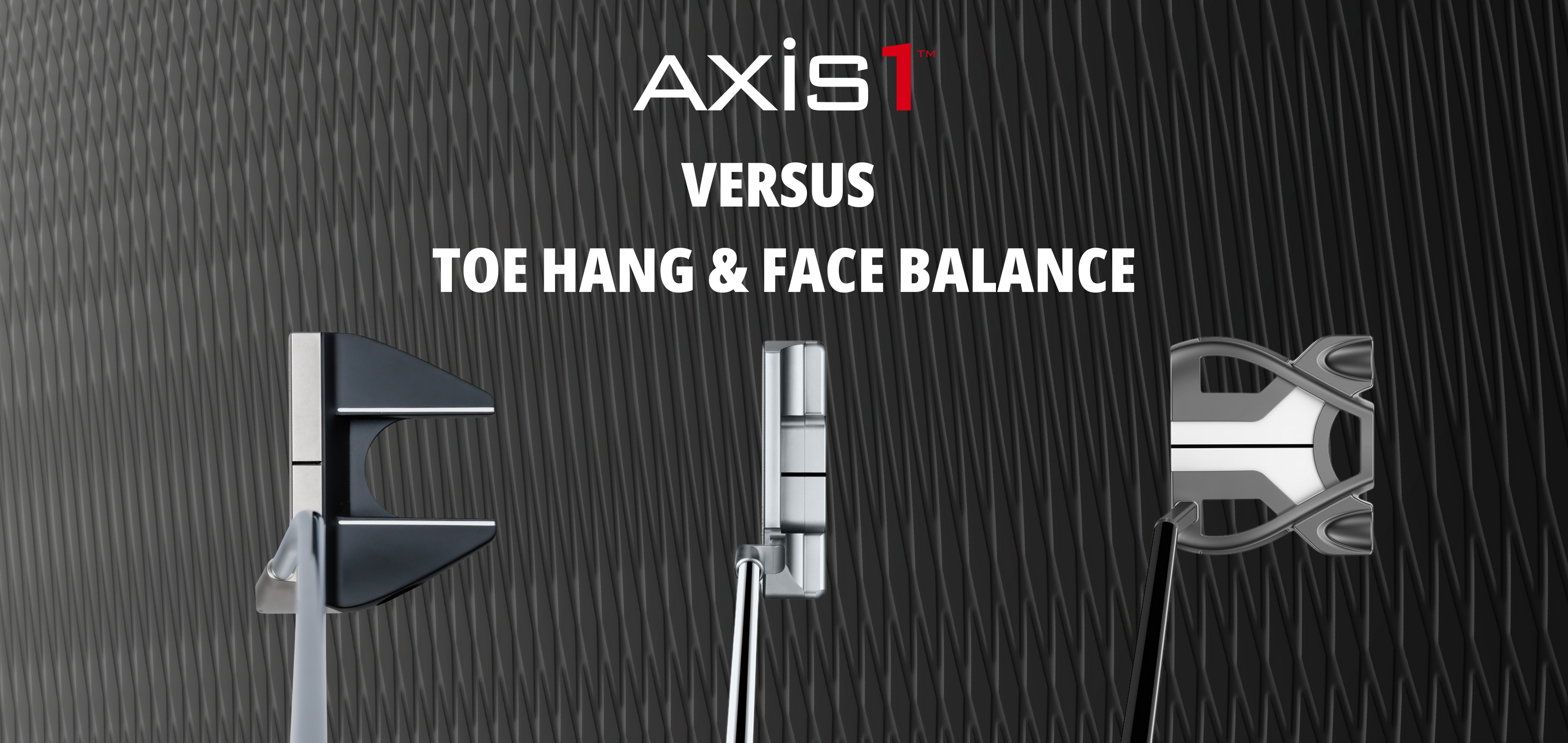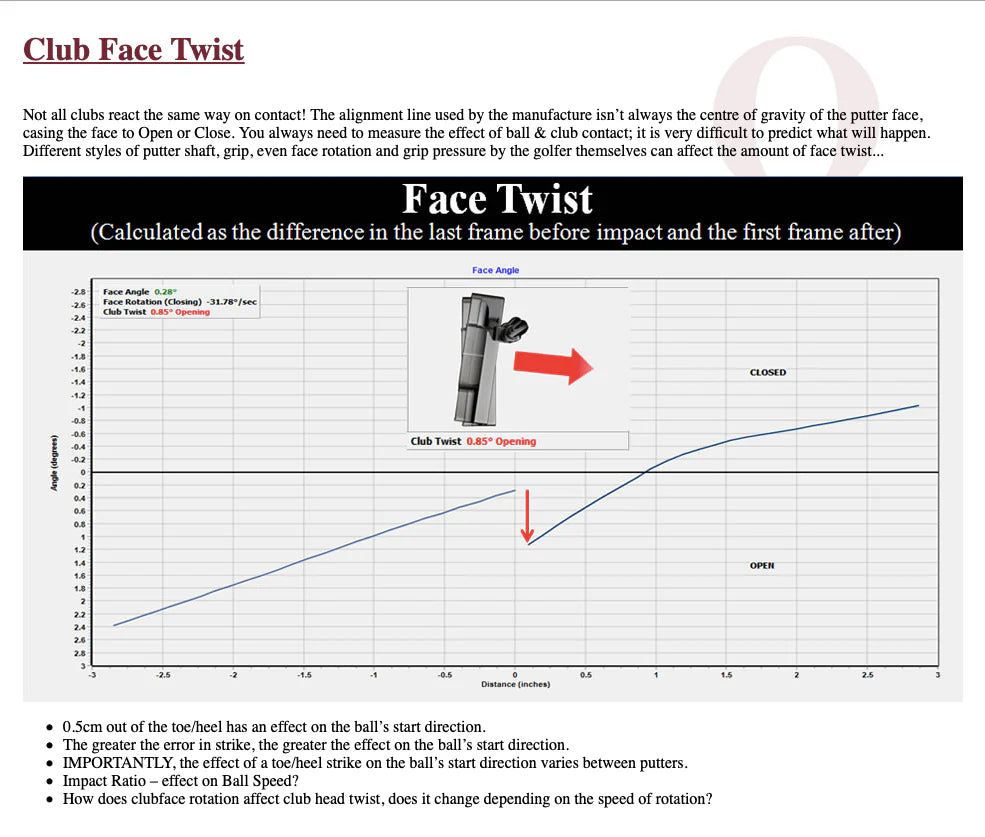
How Axis1’s “Perfect Balance / Torque-Free”™ Patented Technology differs from Traditional Toe Hang and Face Balance Putters
Axis1 is the first and original innovator and creator of “Perfect Balance / Torque-Free”™ technology, the third major putting innovation following the evolutions of perimeter weighting and alignment features on putters. Axis1 developed this technology over 10 years ago and owns the patents for placing the center of gravity of a putter, exactly on the center of the striking face and in line with the axis of the shaft and grip. A feat never accomplished in the history of golf and creating the world’s first “Perfect Balance / Torque Free” ™ Putters.
In an increasingly complex and crowded putter market presenting golfers with numerous putter options, it is important for golfers to not only understand the technical aspects of what makes “Perfect Balance / Torque-Free”™ technology, but why it is different than traditional toe hang and face balance putters.
Axis1’s Technology Explained
So, what does Perfect Balance and Torque-Free mean? There are four main factors (listed below) that golfers should be familiar with to fully understand our patented technology and how “Perfect Balance / Torque-Free”™ technology is achieved.
- Center of the Striking Face: The center point of the striking face is exactly in line both horizontally and vertically, with the center of the putter head. This is the optimal point on the putter face where contact with the golf ball produces the best results.
- Center of Gravity (CG) of the Putter Head: As part of achieving perfect balance and torque-free putters with zero-twist, the CG of the putter head should be exactly on, or in-line with the center of the striking face.
- Grip Axis: The grip axis on a putter refers to the imaginary line that runs vertically through the center of the grip and extends down the shaft. This relationship between the grip axis and the CG of the putter plays an important role in determining how much torque is transferred from the putter head to the golfer’s hands. The more twisting force that is transferred to the hands, the more you must work to keep the putter face square to your target line throughout your stroke. The relationship between the grip axis and the CG or head axis of the putter influences the stability, feel, and consistency of the putter when contacting the ball
- Shaft Axis: The shaft axis on a putter refers to the imaginary line that runs along the length of the putter shaft, from the grip to where the shaft meets the putter head. This axis plays a key role in how the head weight of the putter transfers torque to the grip axis and ultimately to the golfer’s hands.
If any of these variables are not fully aligned, there will be imbalance and torque. In putting, the misalignment of these variables results in torque, which is the twisting force that occurs when the putter face doesn't stay square during your stroke. This twisting can lead to misalignment and inaccurate putts. Eliminating torque is crucial for maintaining control, accuracy, and consistency on the greens.

Axis1 accomplishes “Perfect Balance / Torque-Free”™ technology by placing the CG perfectly in line with the center of the striking face and aligning it precisely with shaft and grip axis. This alignment allows for the most forward CG placement of any putter on the market. By moving the CG forward we produce zero twist on center strikes and minimal twist on off-center hits while delivering very consistent ball speeds and launch angles throughout the entire putter face. This innovative design helps eliminate common putting errors and ensures more putts hold their line.
Why is Axis1’s “Perfect Balance / Torque-Free”™ technology important to golfers?
- 50% of all strokes in a round of golf are with your putter (36 out of 72 strokes in a round of golf are with your putter)
- The only place where you can save strokes is by making more putts
- 1 stroke can be the difference between making the cut or the money
- Use a putter that holds the line rather than taking you off-line
How does Axis1’s “Perfect Balance / Torque-Free”™ technology improve putting performance?
Well, for starters, Justin Rose’s stats while using Axis1 says it all:
- Since switching to Axis1 in 2019, Justin Rose has picked up +61.9 Strokes Gained Putting (SGP) in the Major Championships (21 strokes better than the next closest competitor).
- Led the field in SGP +4.95 (2023 Ryder Cup).
- Led the field in SGP +6.08 (2023 Masters).
- Led the field in SGP +11.727 (2021 PGA Championship).
Axis1 is tour proven with over $16m earned on the PGA Tour, including 2 PGA Tour wins and 26 Top 10 PGA Tour finishes, plus 7 Top 10 finishes in the Majors and 2 in The Players.
This becomes even more clear when you compare it to traditional toe hang and face balance alternatives.
How This Compares to Toe Hang Putters
- Shaft Axis: The shaft axis does not align with the center of gravity and the center of the striking face, instead it is aligned towards the heel of the putter.
- Grip Axis: The grip axis does not align with the center of gravity and center of the striking face but rather towards the heel of the putter.
- Center of Gravity: the center of gravity is not on the center of the striking face.
Given the above factors, toe hang putters have their weight distributed more heavily toward the toe, causing the face to naturally open during the stroke. Golfers must actively square their face at impact, which requires precise timing, resulting in pushed or pulled putts even with even the slightest error.

How This Compares to Face Balance Putters
- Shaft Axis: The shaft axis does not align with the center of gravity and the center of the striking face, instead it is aligned towards the heel of the putter.
- Grip Axis: The grip axis does not align with the center of gravity and center of the striking face but rather towards the heel of the putter.
- Center of Gravity: the center of gravity is not on the center of the striking face and is located further back in the putter head.
Face balance putters aim to reduce face rotation by keeping the face pointing up when balanced, but they are not free from torque. Given the heel aligned shaft and grip axis, combined with the center of gravity typically being placed well behind the face, there will be a tendency to twist causing torque if the stroke isn’t perfectly executed.

So, why use Axis1?
When deciding on different putter options, golfers should be asking themselves the following questions:
- Would I rather use a putter that twists or doesn’t twist on center strikes?
- Would I rather use a putter that shows a face returning to square at impact or would I rather depend on “timing” to get your putter back to square at impact?
- Even if I have perfect timing every time, which not even PGA Tour players have, and can deliver the putter back to square at impact, will I have consistent launch direction off the face when my putter either twists open or closed at impact?
We are not trying to persuade golfers one way or another, but simply want to make sure golfers are making an educated decision before purchasing a putter.
As in so many aspects of golf, it is the small things that truly make a difference - why not remove one more variable and simply focus on your line. After all, we putt for dough.


